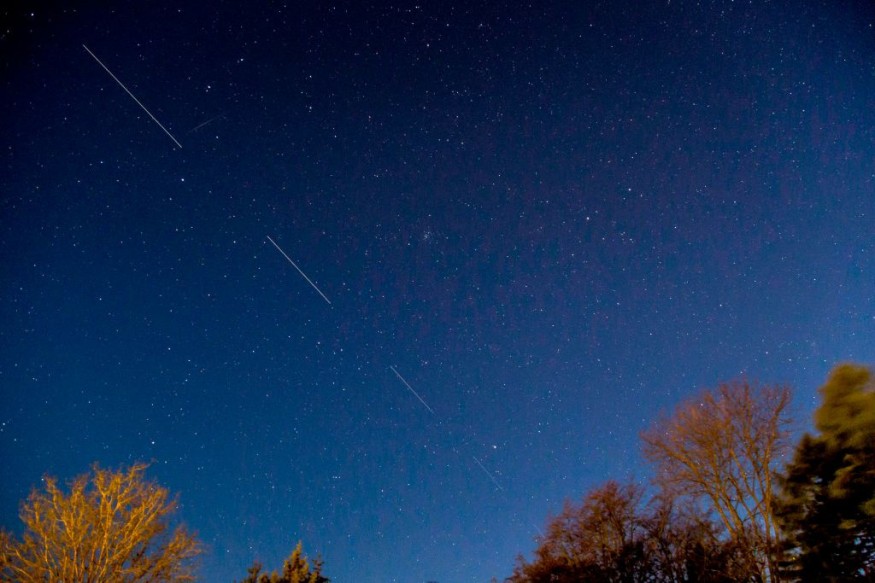Researchers said more twilight photographs are affected as SpaceX deploys more Starlink satellites. As a result, satellite constellations in Low Earth Orbit (LEO) significantly impact astronomy.
Since 2019, SpaceX has been launching its Starlink satellites into orbit. The 36th mission will add 49 more to the network of over 2,000 satellites this week, Science Times said. While this "mega constellation" seeks to provide dependable and fast internet access, it has also raised concerns among astronomers since large LEO satellite constellations have the potential to impede the view of the universe.
For example, skywatchers in cities like Washington and Vancouver saw a weird line of lights in the sky in May 2021, which turned out to be the Starlink satellites launched earlier that day.

SpaceX Starlink Satellites Affect Astronomical Observations
A team of researchers examined the images captured by the Zwicky Transient Facility (ZTF) instrument, which operates from the Palomar Observatory near San Diego, to determine the potential effects of such satellite constellations on astronomical surveys, according to a news release from the California Institute of Technology (Caltech). The researchers focused on Starlink satellites since they are the largest LEO constellation. This device monitors the night sky every two days to analyze changes in the sky over time, according to Caltech.
How much are @SpaceX Starlink satellites polluting the night sky? A new study, led by @przemroz looks at two years of @ztfsurvey data and presents hard evidence. The study appeared in ApJ today and the press release is front page on the @Caltech websitehttps://t.co/OXQXK5Hfvd pic.twitter.com/sWJAuL9GEv
— ZTF Survey (@ztfsurvey) January 17, 2022
Researchers evaluated the archival ZTF observations recorded between November 2019 and September 2021. They found 5301 satellite streaks that may be ascribed to Starlink satellites, the researchers said in their report titled "Impact of the SpaceX Starlink Satellites on the Zwicky Transient Facility Survey Observations." As SpaceX launches additional satellites, we notice that the number of photographs affected grows.
According to the study, the percentage of streaked photos increased from 0.5 percent in late 2019 to 6 percent in late 2020 and even to 18 percent by August 2021. They anticipate that after the Starlink network reaches 10,000 satellites, which SpaceX allegedly hopes to do by 2027, "almost all" of the ZTF twilight photos will be impacted.
ALSO READ : SpaceX Drone Ship Heads Out As Falcon 9 Will Deploy First Set of Starlink Satellites in 2022
SpaceX Starlink Satellite Still Had "No Significant Impact" On ZTF Activities
Despite this, the researchers concluded that the rise of satellite streaks had no "significant impact" on ZTF's science activities.
There's a slight risk we'd miss an asteroid or other event concealed behind a satellite streak, research co-author Tom Prince of Caltech stated in a news release. But compared to the influence of weather, such as a cloudy sky, researchers said these are relatively minor consequences for ZTF.
Furthermore, non-twilight photos may be spared from the Starlink constellation's prospective consequences, according to research lead author Przemek Mróz of the University of Warsaw in Poland, as reported by Caltech. That is, until "another company's satellite network moves into higher orbits."
The researchers also looked at how effective SpaceX's efforts to reconfigure the Starlink satellites have been. Space News said SpaceX introduced visors in 2020 that block sunlight from lighting the satellites' surface, making their reflections appear fainter in response to astronomical concerns. The researchers discovered that the attempt lowered the satellites' brightness by a ratio of 4.6 compared to the original satellites, demonstrating that the method caused "significant darkening."
However, researchers said 67 percent of the visor-type satellite observations are still brighter than the SATCON1 workshop's suggestion #5.
ZTF is still keeping an eye on the Northern sky for the time being, and experts anticipate that it will record many more LEO satellite streaks.
The researchers added that the new ZTF observations will allow us to monitor the situation and give input to the astronomical community as well as satellite operators."
RELATED ARTICLE : Experts Reveal That 3% Of SpaceX's Starlink Satellites Have Failed In Orbit So Far
Check out more news and information on Starlink in Science Times.
© 2025 ScienceTimes.com All rights reserved. Do not reproduce without permission. The window to the world of Science Times.












